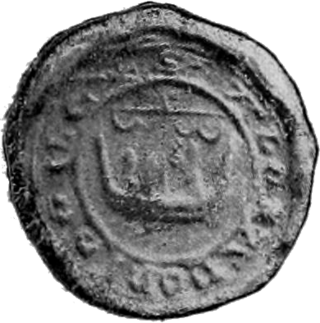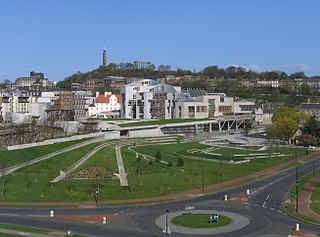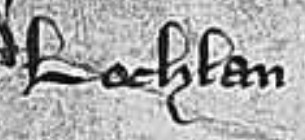Related Research Articles

A Scottish clan is a kinship group among the Scottish people. Clans give a sense of shared identity and descent to members, and in modern times have an official structure recognised by the Court of the Lord Lyon, which regulates Scottish heraldry and coats of arms. Most clans have their own tartan patterns, usually dating from the 19th century, which members may incorporate into kilts or other clothing.

Donnchadh was a Gall-Gaidhil prince and Scottish magnate in what is now south-western Scotland, whose career stretched from the last quarter of the 12th century until his death in 1250. His father, Gille-Brighde of Galloway, and his uncle, Uhtred of Galloway, were the two rival sons of Fergus, Prince or Lord of Galloway. As a result of Gille-Brighde's conflict with Uhtred and the Scottish monarch William the Lion, Donnchadh became a hostage of King Henry II of England. He probably remained in England for almost a decade before returning north on the death of his father. Although denied succession to all the lands of Galloway, he was granted lordship over Carrick in the north.

Clan MacAulay, also spelt Macaulay or Macauley is a Scottish clan. The clan was historically centred on the lands of Ardincaple, which are today consumed by the little village of Rhu and burgh of Helensburgh in Argyll and Bute. The MacAulays of Ardincaple were located mainly in the traditional county of Dunbartonshire, which straddles the "Highland Line" between the Scottish Highlands and Lowlands. Clan MacAulay has been considered a "Highland clan" by writers and has been linked by various historians to the original Earls of Lennox and in later times to Clan Gregor. The MacAulays of Ardincaple, like Clan Gregor and several other clans, have traditionally been considered one of the seven clans which make up Siol Alpin. This group of clans were said to have claimed descent from Cináed mac Ailpín, King of the Picts, from whom later kings of Scotland traced their descent. The chiefs of Clan MacAulay were styled Laird of Ardincaple.

Aonghus Óg Mac Domhnaill, or Angus Og MacDonald, was a fourteenth-century Scottish magnate and chief of Clann Domhnaill. He was a younger son of Aonghus Mór mac Domhnaill, Lord of Islay. After the latter's apparent death, the chiefship of the kindred was assumed by Aonghus Óg's elder brother, Alasdair Óg Mac Domhnaill.

The Whiggamore Raid was a march on Edinburgh by supporters of the Kirk faction of the Covenanters to take power from the Engagers whose army had recently been defeated by the English New Model Army at the Battle of Preston (1648).

Sir Aulay MacAulay of Ardincaple was a Scottish laird, knight, clan chief, and a shire commissioner. He was the son and heir of Walter MacAulay Ardincaple, who was the laird of Ardincaple and chief of Clan MacAulay. The MacAulay estate of Ardincaple was situated in the location of the modern village of Rhu and Helensburgh, which both lie on the eastern shore of the Gare Loch, in Argyll and Bute. As chief of his clan, he entered into a contract with the chief of the MacGregors, pledging service and assistance to their chief. His clan feuded with the Buchanans, and his marriage to the widow of a deceased Galbraith chief brought forth feuding with that clan. He also feuded with the Campbells, particularly the Captain of Carrick. The Campbells made several attempts on his life and he was wounded one such encounter. Towards the end of his life he was knighted for his services. On his death he was succeeded by his first cousin.

A clan badge, sometimes called a plant badge, is a badge or emblem, usually a sprig of a specific plant, that is used to identify a member of a particular Scottish clan. They are usually worn affixed to the bonnet behind the Scottish crest badge, or pinned at the shoulder of a lady's tartan sash. According to popular lore clan badges were used by Scottish clans as a means of identification in battle. An authentic example of plants being used in this way were the sprigs of oats used by troops under the command of Montrose during the sack of Aberdeen. Similar items are known to have been used by military forces in Scotland, like paper, or the "White Cockade" of the Jacobites.

A slogan is used in Scottish heraldry as a heraldic motto or a secondary motto. It usually appears above the crest on a coat of arms, though sometimes it appears as a secondary motto beneath the shield. The word slogan dates from 1513. It is a variant of the earlier slogorn, which was an Anglicisation of the Scottish Gaelic sluagh-ghairm. In other regions it is called war-cry.

Alasdair Óg Mac Domhnaill was Lord of Islay and chief of Clann Domhnaill. He was the eldest son of Aonghus Mór mac Domhnaill, Lord of Islay. Alasdair Óg seems to first appear on record in 1264, when he was held as a hostage of the Scottish Crown for his father's good behaviour. During Alasdair Óg's career, the Scottish realm endured a succession crisis as a result of the unexpected death of Margaret, Maid of Norway, heir to the Scottish throne, in 1290. One of several factions that staked a claim to the throne was the Bruce kindred. Both Alasdair Óg and his father were cosignatories of the Turnberry Band, a pact that may have partly concerned the Bruces' royal aspirations.

The architecture of Scotland includes all human building within the modern borders of Scotland, from the Neolithic era to the present day. The earliest surviving houses go back around 9500 years, and the first villages 6000 years: Skara Brae on the Mainland of Orkney being the earliest preserved example in Europe. Crannogs, roundhouses, each built on an artificial island, date from the Bronze Age and stone buildings called Atlantic roundhouses and larger earthwork hill forts from the Iron Age. The arrival of the Romans from about 71 AD led to the creation of forts like that at Trimontium, and a continuous fortification between the Firth of Forth and the Firth of Clyde known as the Antonine Wall, built in the second century AD. Beyond Roman influence, there is evidence of wheelhouses and underground souterrains. After the departure of the Romans there were a series of nucleated hill forts, often utilising major geographical features, as at Dunadd and Dunbarton.

Clann Ruaidhrí was a leading medieval clan in the Hebrides and the western seaboard of Scotland. The eponymous ancestor of the family was Ruaidhrí mac Raghnaill, a principal member of Clann Somhairle in the thirteenth century. Members of Clann Ruaidhrí were factors in both the histories of the Kingdom of the Isles and the Kingdom of Scotland in the thirteenth- and fourteenth centuries. The family appears to have held power in Kintyre in the thirteenth century. By the fourteenth century, the family controlled an extensive provincial lordship stretching along north-western Scottish coast and into the Hebrides. As a leading force in the Kingdom of the Isles, the family fiercely opposed Scottish authority. With the collapse of Norwegian hegemony in the region, the family nimbly integrated itself into the Kingdom of Scotland.
Scottish surnames are surnames currently found in Scotland, or surnames that have a historical connection with the country.

Christina of the Isles was a fourteenth-century Scottish noblewoman. She was daughter of Ailéan mac Ruaidhrí, and a leading member of Clann Ruaidhrí. Although Ailéan had two sons, Lachlann and Ruaidhrí, both appear to have been illegitimate, whereas Christina was legitimate, and possibly a daughter of Ailéan's wife, Isabella.
Dubhghall mac Suibhne was a Scottish landholder in Argyll, and a leading member of Clann Suibhne. He was a son of Suibhne mac Duinn Shléibhe, and appears to have held lordship of Knapdale from at least the 1240s to the 1260s, and may have initiated the construction of Skipness Castle and Lochranza Castle.
Murchadh Mac Suibhne was a leading member of Clann Suibhne. He was a grandson of the family's eponymous ancestor Suibhne mac Duinn Shléibhe, and a nephew of the family's mid-thirteenth-century representative, Dubhghall mac Suibhne.

Eóin Mac Suibhne was a fourteenth-century Scottish nobleman and a leading member of Clann Suibhne. In the middle of the thirteenth century, seemingly during the 1260s, Eóin's family appears to have been ejected from its homeland in Argyll by the Stewart/Menteith kindred. It may have been during this period that members of Clann Suibhne took up residence in Ireland.
Raghnall Mac Ruaidhrí was an eminent Scottish magnate and chief of Clann Ruaidhrí. Raghnall's father, Ruaidhrí Mac Ruaidhrí, appears to have been slain in 1318, at a time when Raghnall may have been under age. Ruaidhrí himself appears to have faced resistance over the Clann Ruaidhrí lordship from his sister, Cairistíona, wife of Donnchadh, a member of the comital family of Mar. Following Ruaidhrí's demise, there is evidence indicating that Cairistíona and her powerful confederates also posed a threat to the young Raghnall. Nevertheless, Raghnall eventually succeeded to his father, and first appears on record in 1337.

Lachlann Mac Ruaidhrí was a Scottish magnate and chief of Clann Ruaidhrí. He was a free-booting participant in the First War of Scottish Independence, who remarkably took up arms against figures such as John, King of Scotland; Edward I, King of England; the Guardians of Scotland; and his near-rival William II, Earl of Ross. Lachlann disappears from record in 1307/1308, and appears to have been succeeded by his brother, Ruaidhrí, as chief of Clann Ruaidhrí.
Ruaidhrí Mac Ruaidhrí was a fourteenth-century Scottish magnate and chief of Clann Ruaidhrí. He was an illegitimate son of Ailéan mac Ruaidhrí, and is recorded to have participated in the kindred's military actions against supporters of both the English Crown and Scottish Crown. Following the apparent death of his brother, Lachlann, Ruaidhrí appears to have taken control of the kindred, and firmly aligned the family with Robert I, King of Scotland. Ruaidhrí may well be the member of Clann Ruaidhrí who is recorded slain at the Battle of Faughart in support of the Bruce cause in Ireland. After his death, Ruaidhrí's half-sister, Cairistíona, attempted to transfer the Clann Ruaidhrí territories outwith the family. Ruaidhrí was survived by a daughter, Áine, and an illegitimate son, Raghnall. The latter fended off Cairistíona's actions and succeeded to the chiefship of Clann Ruaidhrí.
References
- Adam, Frank; Innes, Thomas (2004). The Clans, Septs and Regiments of the Scottish Highlands 1934 (reprint ed.). Kessinger Publishing. pp. 27. ISBN 978-1-4179-8076-5.
- Campbell of Airds, Alastair (2002). A History of Clan Campbell: From Flodden to the Restoration: (Volume 2 of A History of Clan Campbell) (illustrated ed.). Edinburgh University Press. p. 94. ISBN 978-1-902930-18-3.
- Fox, Richard Gabriel (1971). Kin, clan, raja, and rule: statehinterland relations in preindustrial India (reprint ed.). University of California Press. pp. 146.
- Roberts, John Leonard (2000). Clan, king, and covenant: history of the Highland clans from the Civil War to the Glencoe Massacre (illustrated ed.). Edinburgh University Press. p. 134.